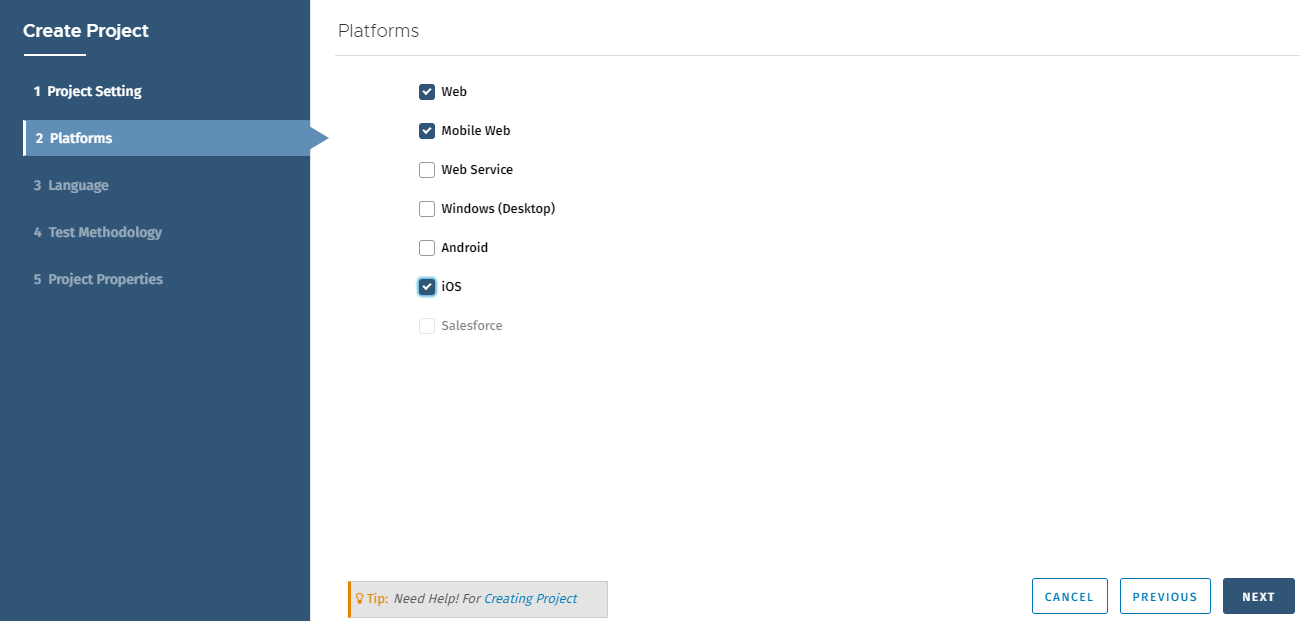...
You can start automation with your favorite programming language like Java, Python, Typescript, Javascript. Most used frameworks like Web, MobileWeb, Android, iOS, Web Services, Windows (Desktop), Salesforce platforms are supported. When you create a project, boilerplate code will be auto generated which you can extend with your Test Cases and required assets.
...
| Platform | Programming Language | Framework | |
|---|---|---|---|
| BDD Test Methodology | TDD Test Methodology | ||
| Web | Java | QAF | Cucumber | TestNG | JUnit |
| Python | Behave | Robot | |
| JavaScript | Cucumber | Jasmine | |
| TypeScript | Cucumber | Jasmine | |
| Web Service | Java | QAF | Cucumber | TestNG |
| Mobile Web | Java | QAF | Cucumber | TestNG | JUnit |
| Python | Behave | Robot | |
| JavaScript | Cucumber | Jasmine | |
| TypeScript | Cucumber | Jasmine | |
| Android | Java | QAF | Cucumber | TestNG | JUnit |
| Python | Behave | Robot | |
| iOS | Java | QAF | Cucumber | TestNG | JUnit |
| Python | Behave | Robot | |
Window (Desktop) | Java | QAF | Cucumber | TestNG |
| Python | Behave | ||
| Salesforce | Java | QAF | |
First, you need to select Platform(s), then Programming Language(s), and then Framework(s).
...
Platform selection is the first step on the QAS Project Setup Wizard. You can select multiple Platforms for your project.
Note: To create a project with the Salesforce platform, users should have purchased the SFDC App of QAS. QAS supports recording of Salesforce test cases on Classic as well as Lightning mode.
Select the platform(s) and click Next.
Step 3. Language
For the selected Platforms, the options to select Programming Languages are displayed.
...
| Platform | Additional Options | Description | Example |
|---|---|---|---|
| Web | Base URL | https://testmanagement.qmetry.com | |
| Web Service | API Base URL | https://api.google.com | |
| Windows (Desktop) | Application Id | Application identifier or executable full path. | Microsoft.WindowsCalculator_8wekyb3d8bbwe!App |
| Android* | App Path | The path of the apk file of the Android app that you want to run. The path could be of URL or your local machine/remote machine. On entering the App Path, the App Package and App Activity populate automatically in the next fields. (Android Studio should have been installed for the Android projects.) | http://{baseurl}/bank/app.apk D:\Mobile\app.apk |
| App Package | Java package of the Android app you want to run. By default, this capability is received from the package manifest (@package attribute value) | com.example.android.contactmanager | |
| App Activity | Activity name for the Android activity you want to launch from your package. This often needs to be preceded by a . (e.g., .MainActivity instead of MainActivity). By default this capability is received from the package manifest (action: android.intent.action.MAIN , category: android.intent.category.LAUNCHER) | com.example.android.contactmanager.ContactManager | |
| iOS | App Path | The path of the apk file of the Android app that you want to run. The path could be of URL or your local machine/remote machine. On entering the App Path, the Bundle Id populates automatically in the next field. (Xcode should have been installed for the iOS projects.) | http://{baseurl}/bank/app.apk D:\Mobile\app.apk |
| Bundle Id | Bundle ID of the app under test. Useful for starting an app on a real device or for using other caps which require the bundle ID during test startup. To run a test on a real device using the bundle ID, you may omit the 'app' capability, but you must provide 'udid'. | io.example.com | |
| Mobile Web | Base URL | It is a mobile site URL. | https://testmanagement.qmetry.com |
| Salesforce | Base URL |
* Refer to How to fetch App Activity and App Package? for details.
...

